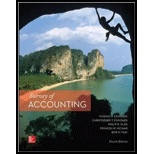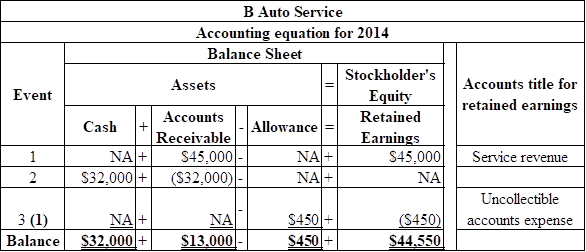
Concept explainers
a.
Show the effect of each transaction on the
a.
Explanation of Solution
Show the effect of each transaction on the accounting equation for 2014:

Table (1)
Show the effect of each transaction on the accounting equation for 2015:

Table (2)
Working note 1: Calculate the Uncollectible accounts expenses for 2014:
Estimated Uncollectible accounts are 1% of the revenue on account. Revenue on account is $45,000.
Working note 2: Calculate the Uncollectible accounts expenses for 2015:
Estimated Uncollectible accounts are 1% of the revenue on account. Revenue on account is $65,000.
b. (1)
Ascertain the net income for 2014.
b. (1)
Explanation of Solution
Net income: Net income is the excess amount of revenue which arises after deducting all the expenses of a company. In simple terms, it is the difference between total revenue and total expenses of the company.
Ascertain the net income for 2014:
Hence, the net income for 2014 is $44,550.
b. (2)
Ascertain the net
b. (2)
Explanation of Solution
Cash flows from operating activities: These refer to the cash received or cash paid in day-to-day operating activities of a company.
During 2014, cash collected from the customers is $32,000, and there is no cash payments made during the year, therefore the net cash flows from the operating activities are $32,000.
b. (3)
Ascertain the balance of accounts receivables at the end of 2014.
b. (3)
Explanation of Solution
The Accounts receivable balance at the end of 2014 is $13,000 (Refer Table (1)).
b. (4)
Ascertain the net realizable value of accounts receivables at the end of 2014.
b. (4)
Explanation of Solution
Cash realizable value (net realizable value): Cash realizable value is the net amount of receivables which a business expects to collect from its debtors. Accounts receivable less allowance for doubtful accounts is represented as cash realizable value.
Ascertain the net realizable value of accounts receivables at the end of 2014:
Thus, the Net realizable value of accounts receivable at the end of the 2014 is $12,550.
c. (1)
Ascertain the net income for 2015.
c. (1)
Explanation of Solution
Net income: Net income is the excess amount of revenue which arises after deducting all the expenses of a company. In simple terms, it is the difference between total revenue and total expenses of the company.
Ascertain the net income for 2015:
Hence, the net income for 2015 is $64,350.
c. (2)
Ascertain the net cash flows from operating activities for 2015.
c. (2)
Explanation of Solution
Cash flows from operating activities: These refer to the cash received or cash paid in day-to-day operating activities of a company.
During 2015, cash collected from the customers is $66,000, and there is no cash payments made during the year, therefore the net cash flows from the operating activities are $66,000.
c. (3)
Ascertain the balance of accounts receivables at the end of 2015.
c. (3)
Explanation of Solution
Accounts receivable: Accounts receivable refers to the amounts to be received within a short period from customers upon the sale of goods and services on account. In other words, accounts receivable are amounts customers owe to the business. Accounts receivable is an asset of a business.
The Accounts receivable balance at the end of 2015 is $11,680 (Refer Table (2)).
c. (4)
Ascertain the net realizable value of accounts receivables at the end of 2015.
c. (4)
Explanation of Solution
Cash realizable value (net realizable value): Cash realizable value is the net amount of receivables which a business expects to collect from its debtors. Accounts receivable less allowance for doubtful accounts is represented as cash realizable value.
Ascertain the net realizable value of accounts receivables at the end of 2015:
Thus, the Net realizable value of accounts receivable at the end of the 2015 is $10,900.
Want to see more full solutions like this?
Chapter 5 Solutions
Survey Of Accounting
- Solve this Accounting Problemarrow_forwardI need guidance on solving this financial accounting problem with appropriate financial standards.arrow_forwardLMN Company reported net income of $87,500 for the year. If the company's total expenses were $142,500, what was the company's total revenue for the year? Answerarrow_forward

 AccountingAccountingISBN:9781337272094Author:WARREN, Carl S., Reeve, James M., Duchac, Jonathan E.Publisher:Cengage Learning,
AccountingAccountingISBN:9781337272094Author:WARREN, Carl S., Reeve, James M., Duchac, Jonathan E.Publisher:Cengage Learning, Accounting Information SystemsAccountingISBN:9781337619202Author:Hall, James A.Publisher:Cengage Learning,
Accounting Information SystemsAccountingISBN:9781337619202Author:Hall, James A.Publisher:Cengage Learning, Horngren's Cost Accounting: A Managerial Emphasis...AccountingISBN:9780134475585Author:Srikant M. Datar, Madhav V. RajanPublisher:PEARSON
Horngren's Cost Accounting: A Managerial Emphasis...AccountingISBN:9780134475585Author:Srikant M. Datar, Madhav V. RajanPublisher:PEARSON Intermediate AccountingAccountingISBN:9781259722660Author:J. David Spiceland, Mark W. Nelson, Wayne M ThomasPublisher:McGraw-Hill Education
Intermediate AccountingAccountingISBN:9781259722660Author:J. David Spiceland, Mark W. Nelson, Wayne M ThomasPublisher:McGraw-Hill Education Financial and Managerial AccountingAccountingISBN:9781259726705Author:John J Wild, Ken W. Shaw, Barbara Chiappetta Fundamental Accounting PrinciplesPublisher:McGraw-Hill Education
Financial and Managerial AccountingAccountingISBN:9781259726705Author:John J Wild, Ken W. Shaw, Barbara Chiappetta Fundamental Accounting PrinciplesPublisher:McGraw-Hill Education





